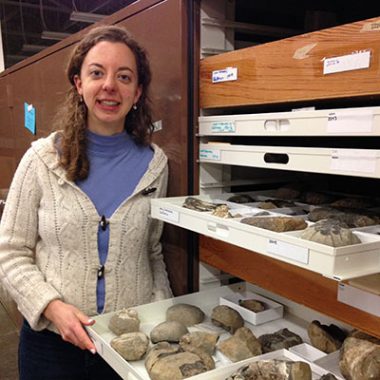Former Staff
Why collections? "Each fossil has a story to tell, but in order to decipher it you need to know where the fossil came from, who collected it and when. I enjoy ensuring that these links between objects and data are preserved, and continuing to find better ways to communicate this information to researchers and the public."
Federal collections: "Before coming to UCMP, I worked as a paleontologist for the National Park Service (NPS). Since arriving in Berkeley, I have been privileged to collaborate with the Pacific West Region of NPS. We are working on a number of projects including a paleontological inventory for Golden Gate National Recreation Area, a portal for NPS staff to view detailed UCMP locality information and a long-term field monitoring program for Point Reyes National Seashore. These collaborations benefit both UCMP and NPS, through improved accuracy of data and better care of collections."
Research interests: "I like studying unusual organisms and environments. This has included characterizing clotted microbial mats called thrombolites that grew around living trees in brackish water. The thrombolites are preserved in building stone quarry walls in the Jurassic-aged chalk cliffs of southern England. For my Master's thesis I described a new sponge-like organism from the Ediacaran strata of south Australia. The earliest macroscopic organisms are Ediacaran in age, and this organism was significant because it consisted of two different types of tissue, with ruler-straight spicules disarticulating from the cone-shaped body of the organism after death. Coronacollina also resembles the Cambrian sponge, Choia, providing a rare link across the Precambrian-Cambrian boundary.
Current projects: Erica is the coordinator for the EPICC TCN, a group of nine museums digitizing marine invertebrate fossils from the eastern Pacific over the last 66 million years of Earth's history.
See my NPS profile and an article about my time with GeoCorps America.
Selected Publications
- Powell, II, C.L., E.C. Clites, and A.W. Poust. 2019. Miocene marine macropaleontology of the fourth bore Caldecott Tunnel excavation, Berkeley Hills, Oakland, California, USA. PaleoBios, 36.
- Marshall, C.R., S. Finnegan, E.C. Clites, P.A. Holroyd, N. Bonuso, C. Cortez, E. Davis, G.P. Dietl, P.S. Druckenmiller, R.C. Eng, C. Garcia, K. Estes-Smargiassi, A. Hendy, K.A. Hollis, H. Little, E.A. Nesbitt, P. Roopnarine, L. Skibinski, J. Vendetti, & L.D. White. 2018. Quantifying the dark data in museum fossil collections as palaeontology undergoes a second digital revolution. Biology Letters, 14: 20180431 (4 pages). Read it
- Kahanamoku, S.S., P.M. Hull, D.R. Lindberg, A.Y. Hsiang, E.C. Clites and S. Finnegan. 2018. Twelve thousand recent patellogastropods from a northeastern Pacific latitudinal gradient. Scientific Data, 5:170197. Read it
- Pearson, L.K., E.C. Clites, V.L. Santucci and R.W. Boessenecker. 2016. Protocols for paleontological site Monitoring at Point Reyes National Seashore. Natural Resource Report NPS/NRSS/NRR - 2016/1185. National Park Service, Fort Collins, Colorado.
- Stevens, C.H. and E.C. Clites. 2016. Transfer of the Calvin H. Stevens coral collection to the University of California Museum of Paleontology, Berkeley, California: Journal of Paleontology, v. 90, p.182. Read it

Contact
Email: eclites@berkeley.edu